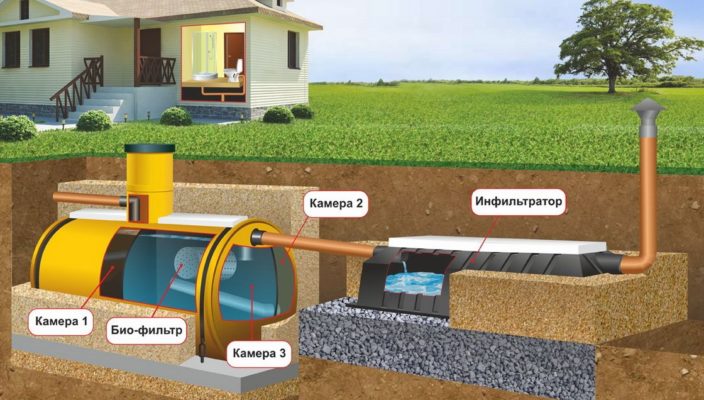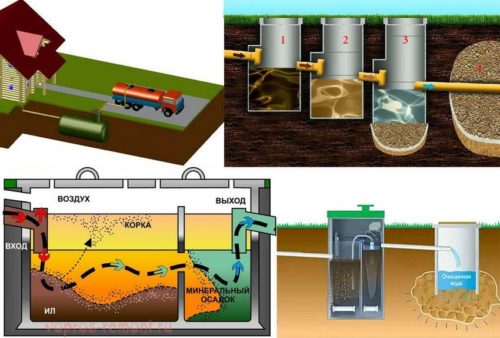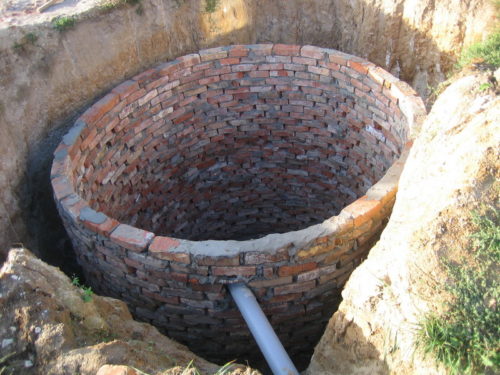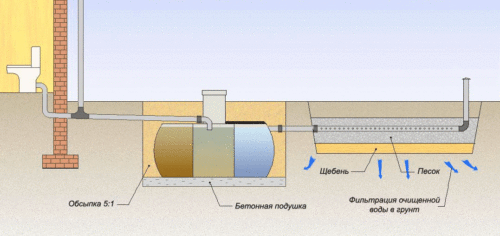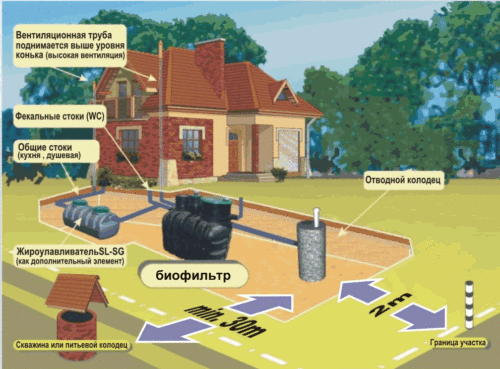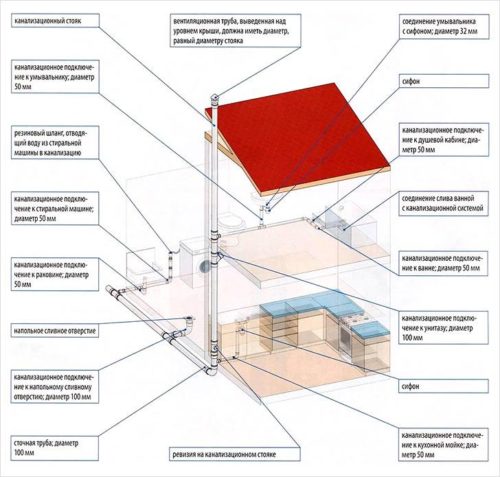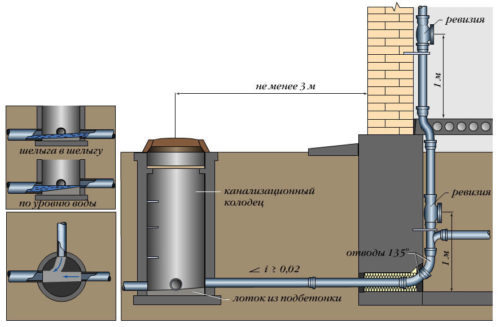The reliability and smoothness of the sewer system directly determine the sufficient level of accommodation in any home. About the device and regulations of the installation of sewage in the country with their own hands and will be discussed in our article.
Content
The principle of sewage operation in the country
The sewer system is engineering communications intended for transportation, accumulation, cleaning and wastewater removal. It consists of two parts: internal and outdoor.
The inner part of the sewage consists of plumbing and pipes that are bodied to it and are paved inside the house. The outer system is the accumulative (cleaning) facilities to which pipes from home are connected.
The principle of operation of the sewer system:
- wastewater from the toilet, washing and dishwasher, baths and shells fall into the pipe inside the house;
- on the pipe laid outside the house, they are sent to the accumulative tank;
- in the tank, they are cleaned and disassembled into the soil.
Wastewater can be directed to the tank as a natural way (under a slope) and by using pumping equipment. The second option is required when locating the bathroom in the basement of the house.
Varieties of sewage systems
There are such types of sewer tanks:
- cesspool;
- cumulative tank;
- overflow sumps;
- septic with a filtration field;
- biological cleaning stations.
Sewage at the cottage - cesspool
It is the cheapest type of cumulative sewage to give. In most cases, for the device, the cesspool uses bricks, slagoblock or concrete rings. Drainage design is carried out with the help of rubble and sand, which are stacked on the bottom of the pit. Sand and crushed stone delay solid particles, and water goes into the ground.
The probability of using a cesspool depends on the depth of groundwater. The pumping of solid particles is carried out using an assessing machine. For this reason, with the organization of the production of country sewage, you should provide free access to the vehicle entry.
The lack of cesspool is a huge probability of soil pollution and drinking water sources with an amount of 70 m³. With such a load will not cope with bacteria that live in the ground.
Sewerage in the country - cumulative tank
This tank is more acceptable in terms of ecology. Cumulative tanks may have different sizes and manufactured from various materials. The plastic reservoir is the perfect option for the area where the groundwater is too close to the surface.
The only "minus" of cumulative products is more frequent use of the assessionator. Therefore, such tanks are suitable only when the cottage is intended for seasonal family living.
Sewerage at the cottage - overflow sumps
They are 2-3 tanks that are connected by pipes. For their manufacture, usually use concrete rings.
Purification of waste water and in the ground in several steps:
- In the first tank to accumulate the heaviest particles.
- Dirty water without heavy particles flows into the second well, where the separation of other particles.
- In the third tank clean water goes into the soil through the drainage from the gravel and sand at the bottom of the sump.
This type of sewage lagoons characterized by maximum efficiency. The drawback - availability of a large area for its device. When using the overflow tank in areas with shallow groundwater from the third tank effluent is pumped by the pump.
Nor do without scavengers. But the waste effluent is pumped out less than when using a sump or storage tank.
Sewerage system in the country - a septic tank with the filter field
Septic - specially equipped vessel, in which the biological treatment of wastewater at 55-65%. Last water treatment takes place in the filtration field.
The operating principle of the design is similar to the operation of overflow wells. Now it released a large number of septic tanks. Their main advantage - the ability to service a solid number of people.
The disadvantage of this type of sewage - the existence of free space in the area for the filtration field, which must comply with the established sanitary standards.
Drainage in the country - biological treatment plant
The most effective method of purification of sewage. The station consists of 4-5 chambers for storing and processing the waste by aerobic bacteria. The waste water can even be used for irrigation of the land.
biological purification installation can be of two types:
- Autonomous. The principle of operation is based on the natural formation of aerobic bacteria.
- Volatile. Due to the electrical connection is made faster wastewater treatment process.
Lack deep cleaning stations - the high cost and the daily intake of wastewater. The latter circumstance is not appropriate for country houses seasonal living.
the question arises among a variety of types of sewage, what type of system to give preference. Among the main factors influencing this decision include:
- seasonal residence (of course, that would be absurd decision on the installation of the treatment plant in the country, where people come only in summer);
- number of family members and the water intake points;
- the depth of groundwater (close to the surface, the occurrence of water does not allow the device filtration fields);
- the type of soil (the process of arranging the optimal sewer system may complicate the presence of clay soil);
- the presence of free space (it is necessary when installing a septica of three wells and a drainage field device);
- free access of the association technology;
- sewing sewage at a distance from the foundation, a source of drinking water, water bodies and vegetables;
- financial opportunities of the owner of a country cottage.
Preparatory stage to sewage arrangement in the country area
At the initial stage, it is necessary to make a diagram of the sewage system, which displays the elements of the internal and external network:
- all plumbing;
- stacked pipes inside the house;
- the outlet point of the building;
- pipes disposed outside of the house;
- claimed facilities.
When drafting a circuit, all distances, diameters and method of pipe laying are defined. Project data should coincide with measurements in the house and on the ground. This is due to the fact that even a minor error can cause damage to the entire system.
Device internal sewage
The wiring inside the house involves laying the pipes that are sent to the riser. The riser is connected to the highway, in which the wastewater is sent to the street.
The process of creating a sewer system inside the house begins with styling of pipes and connects plumbing to them, from where the waste water will merge. Pipes can be both attached to the walls of the clamps and lay under flooring and in the strokes of the walls.
The internal sewage device consists of two main steps:
- installation of riser;
- fastening horizontal pipes.
The riser is a vertical collector, with which all pipes are connected. The lower part of the riser is located in the foundation, through the hole of which the internal sewage is connected to the outer system.
In a place where the riser will touch the wall, make marks. If desired, the strob is drilled a little more than the diameter of the pipe. But in most cases the collector is placed outside the wall. It is so easier to replace it (if there is a need for this). Reliable fixation of the riser is achieved with the help of clamps and brackets in a step of 2-3 m.
The pipe laying is carried out with the presence of a clearance from the wall at 3-4 cm. Adjacent pipes are tightly connected by fittings with seals, thanks to which wastewater will not penetrate outward. If the pipes are packed through the wall, then the fastening step is 0.5-0.6 m. In places of connection, plumbing should be provided with taps.
Several Councils of specialists in internal work:
- Installation of pipes is carried out with the presence of a slope. This indicator depends on the diameter of the pipes. When using pipes with a diameter of 5 cm, the slope is 3 cm / 1 m, 10-11 cm - 2 cm / 1 m, 15 cm - 1 cm / 1 m.
- A siphon is necessarily mounted between the sewer pipe and plumbing. Its main purpose is to keep water, thanks to which the smells of waste water do not fall into the room.
- The kitchen draining the sink is equipped with a fat trap.
- The minimum diameter of the pipe removal from the bathroom, the washing machine, the shells should be 5 cm, from the toiletz - 10 cm.
- The toilet is recommended to mount near the riser, at the lowest point of horizontal wiring. The length of the pipe to the riser should not exceed 1 m.
- In rooms with sewage pipes it is desirable to make a ventilation system. Ventilation pipes are displayed above the roof.
Features of creating outdoor sewage
The procedure for an autonomous sewage device in the country is practically similar to the above-described pipe laying technology (adherence to the slope, a reliable connection of the joints). Differences are to implement earthworks and compliance with the requirements for work in street conditions.
Pipe laying is carried out in compliance with the following rules:
- the depth of their bookmark must exceed the point of the soil freezing;
- if the soil freezes close to the surface, the pipes are covered with thermal insulating material;
- on turns and in long sections, auditing wells are mounted (every 8-10 m).
Outdoor work for country sewage is provided for:
- digging trenches;
- creation of a sand pillow at the bottom of trenches (up to 10 cm thick);
- laying pipes under a slope with the subsequent connection with the septic
- filling with sand space between pipes and trench walls;
- the final backing of the trench of the earth.
The initial point for tubes of external sewage is a pipe that comes out of the foundation of the house. The finishing stage is a septic device (cesspool, a biological station).
Installation of septicity consists of such steps:
- drying is a size exceeding the size of the septicity of 0.3-0.5 m on all sides;
- leveling bottom;
- the device on the bottom of the sand pillow layer 15-20 cm;
- pouring concrete (under a plastic or concrete tank);
- fixation of septic;
- connection of pipes with sewage treatment;
- arrangement of the filtration field;
- installation of hatches;
- failure of the septicity of the earth.
To remove unpleasant odors and improve the cleaning process in the process of operation in the tanks, it is recommended to pour out (pour) the corresponding biological agents and not tighten with the accuracy of the accuracy machine to reject the accumulated unclean.
Video on the sewage device in the country with their own hands:

